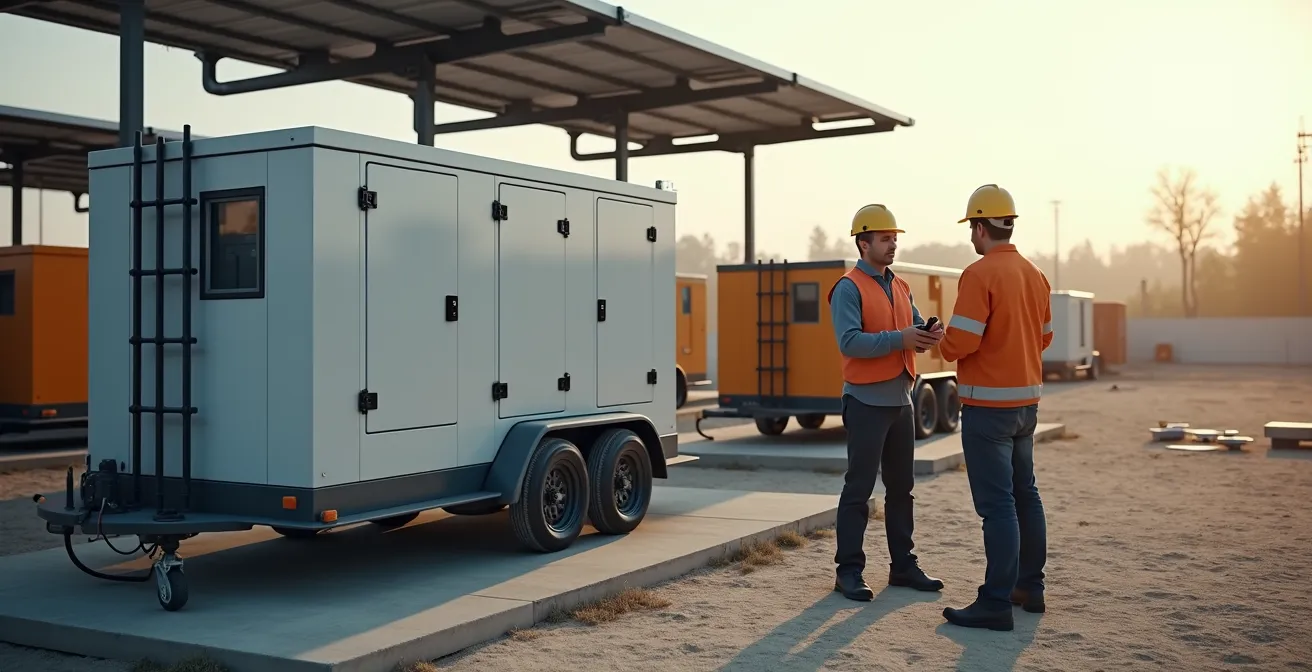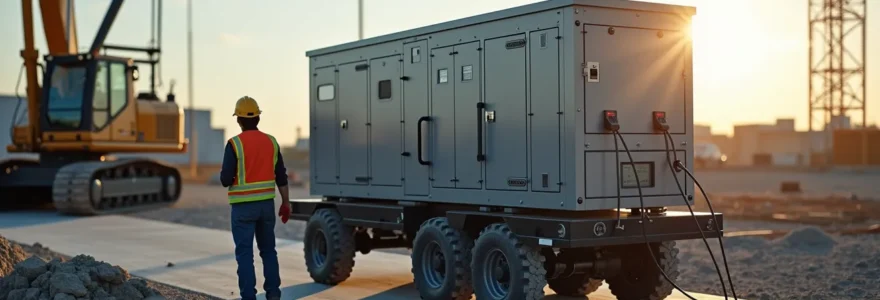The familiar rumble of a diesel generator has long been the soundtrack to progress on construction sites, at events, and in remote locations. Yet, this dependency is being challenged by a quieter, smarter, and more efficient alternative. The conversation is shifting from simply getting power to getting it intelligently. While the environmental benefits are a significant driver, the real revolution lies in understanding the superior Total Cost of Ownership (TCO) and operational intelligence offered by advanced mobile energy storage solutions.
This analysis moves beyond a simple green checklist to a strategic financial and operational assessment. Choosing the right temporary power source is no longer just about wattage and fuel; it’s about optimizing budgets, enhancing productivity, and future-proofing your operations against rising fuel costs and tightening regulations. By focusing on the complete economic picture, the case for battery-based systems becomes not just compelling, but financially prudent.
Your Power Strategy in 4 Key Points
- Understand why traditional generators are facing new operational and financial pressures beyond just emissions.
- Learn a practical framework to accurately assess your project’s specific power needs and constraints.
- Dive into a Total Cost of Ownership (TCO) comparison that reveals the hidden expenses of diesel power.
- Explore advanced strategies for integrating mobile storage to maximize efficiency and operational resilience.
The evolving power landscape: why traditional generators are no longer the only answer
The energy paradigm is undergoing a significant transformation, driven by strained conventional power grids and a surging demand for distributed, flexible energy solutions. This shift is not merely about reducing emissions; it’s a response to broader operational, regulatory, and sustainability pressures. Traditional diesel generators, once the undisputed workhorses of temporary power, are now being re-evaluated in the face of these new realities. The market is clearly responding, evidenced by the 53% surge in global battery storage deployments in 2024.
This evolving landscape introduces Mobile Energy Storage (MES) as a fundamental shift in temporary power. These systems, often called Battery Energy Storage Systems (BESS), offer a spectrum of advantages that extend far beyond their green credentials, addressing the core limitations of combustion-based generators. The practical applications are already proving their worth; as one report notes, mobile BESS have successfully powered construction sites for extended shifts and provided dependable power in remote disaster recovery areas, enabling significant emissions reductions and noise elimination.
Mobile battery energy storage systems offer emissions and noise-free electricity, a cleaner alternative to diesel generators.
– Alex Smith, CTO of Moxion Power, Clean power unplugged: the rise of mobile energy storage
The contrast between the old and new technologies symbolizes a deeper change in how projects can be powered. It represents a move from a brute-force approach to an intelligent, adaptable, and economically sound strategy for managing on-site energy.

Ultimately, MES is not just a replacement but an upgrade, providing silent, reliable, and increasingly cost-effective power that aligns with modern project management demands for efficiency, safety, and corporate responsibility.
What is Mobile Energy Storage (MES)?
Mobile Energy Storage (MES), also known as a mobile BESS (Battery Energy Storage System), is a portable, self-contained unit that stores electricity in batteries. It can be charged from the grid or renewables and deployed to provide silent, emission-free temporary power for construction sites, events, or emergency backup, offering a flexible alternative to traditional diesel generators.
Deconstructing your project’s power needs: a practical framework for selection
Selecting the optimal power solution requires moving beyond guesswork and implementing a structured analysis of your project’s unique demands. A precise understanding of energy consumption, site limitations, and overarching goals is critical to making a financially sound decision. The global market for these solutions is substantial, reflecting their growing importance, with a market value of mobile energy storage at USD 5.73 billion in 2023.
To begin, a systematic approach to quantifying power requirements is essential. This involves evaluating not just the total power needed, but how that need fluctuates over the project’s lifecycle. As experts suggest, these systems enable flexible capacity based on load characteristics, which can reduce costs and improve integration.
Methodology for Quantifying Power Requirements
- Evaluate peak and average load requirements in kW and kWh.
- Consider project duration and phases to estimate time-based needs.
- Assess site constraints including space and environmental factors.
- Balance objectives like cost, sustainability goals, and reliability.
Beyond the numbers, a qualitative assessment of your objectives is just as important. Are you prioritizing the lowest possible upfront cost, or are long-term operational savings and sustainability targets more critical? Answering these questions will guide your selection process and clarify whether a traditional generator, a mobile storage unit, or a hybrid approach is the best fit.
This table summarizes the key factors to consider when assessing your project’s power requirements and how they influence your final technology choice.
| Factor | Description | Impact on Selection |
|---|---|---|
| Power Demand (kW & kWh) | Load and energy needs derived from project phases | Baselines storage capacity and output power |
| Site Constraints | Space, accessibility, environmental regulations | Limits equipment size and placement |
| Budget & Timeline | Upfront and operational costs, project deadlines | Influences technology choice and scale |
| Sustainability Goals | Emission reduction, renewable integration | Drives preference for battery storage over generators |
Mobile energy storage vs. diesel generators: a total cost of ownership (TCO) deep dive
A surface-level cost comparison often favors diesel generators due to their lower initial purchase or rental price. However, a Total Cost of Ownership (TCO) analysis, which accounts for all expenses over the equipment’s lifecycle, reveals a different economic reality. Operational expenditures—fuel, routine maintenance, labor for refueling, and potential environmental permits—significantly inflate the true cost of generator-based power.
Mobile energy storage systems drastically reduce or eliminate many of these variable costs. They require no fuel, have minimal maintenance needs due to fewer moving parts, and operate silently without emissions, avoiding noise complaints and environmental fines. The operating cost comparison of mobile storage and diesel generators often shows a significant advantage for battery systems. This long-term view is crucial for accurate project budgeting.
Below is a comparative breakdown of the key cost aspects between MES and traditional diesel generators, highlighting the long-term financial advantages of battery technology.
| Cost Aspect | Mobile Energy Storage | Diesel Generators |
|---|---|---|
| Lifespan | 50 years (battery system) | 10 years |
| Fuel & Energy Cost | Charge at 10-15 cents/kWh off-peak | 50-75 cents/kWh diesel fuel cost, plus inefficiencies |
| Maintenance | Minimal, no moving parts | Frequent, includes engine servicing and fuel handling |
| Operating Noise & Emissions | Virtually silent, zero emissions | High noise and emissions (CO2, VOCs, NOx) |
| Reliability | Instant dispatch, no idling needed | Idling required, possible fuel delivery challenges |
Beyond these direct costs are significant “soft” benefits that translate into financial gains. Stable, uninterrupted power from an MES unit reduces the risk of equipment failure and costly downtime. The elimination of engine noise and fumes improves worker safety and communication on-site, leading to enhanced productivity. For companies focused on sustainability, using clean energy also bolsters their corporate image. When projects face frequent breakdowns, finding reliable portable power alternatives becomes a top priority.
Mobile storage powering a concrete grinding crew for a week
In a real-world application, mobile battery storage powered battery-powered tools continuously for a full week on a single charge at a construction site, demonstrating superior runtime and cost-efficiency compared to diesel.
Mobile batteries multiply savings through greater reliability, efficiency, and performance compared to diesel generators.
– Alex Smith, CTO of Moxion Power, Clean power unplugged: the rise of mobile energy storage
Key Takeaways
- Mobile Energy Storage (MES) offers a lower Total Cost of Ownership than diesel generators by cutting fuel and maintenance costs.
- Accurately assessing power needs (kW, kWh, duration) and site constraints is crucial before selecting a power solution.
- MES provides significant “soft” benefits like reduced downtime, improved safety, and enhanced corporate sustainability credentials.
- Advanced applications like hybrid systems and site electrification unlock even greater efficiency and operational flexibility for complex projects.
Optimizing your project with MES: advanced applications and integration strategies
The true potential of Mobile Energy Storage is unlocked when it moves beyond being a simple generator replacement to become an integrated part of a sophisticated energy strategy. Hybrid solutions, which combine MES with traditional generators or renewable sources, offer a powerful way to maximize efficiency, resilience, and cost savings across different project phases.
In a hybrid setup, the MES can handle low-load periods, allowing the generator to be shut down entirely, which drastically cuts fuel consumption and engine wear. The generator only kicks in to manage peak loads or recharge the batteries, ensuring it always runs at its most efficient point. This intelligent coordination is a cornerstone of modern on-site power management.

Furthermore, MES is a key enabler for full site electrification. It can provide the robust, clean power necessary to charge electric vehicles (EVs) and run high-demand electric tools, paving the way for diesel-free job sites. Smart features like remote monitoring and automated controls allow for dynamic load balancing, giving project managers unprecedented visibility and control over energy usage, which helps in proactive issue resolution. As some researchers have noted, mobile energy storage provides more flexible charge and discharge regulation to dynamically respond to real-time situations.
Coordinated optimization of fixed and mobile energy storage to enhance photovoltaic integration
A dual-layer optimization model using a PSO-GSA algorithm coordinates fixed and mobile energy storage systems to improve grid voltage stability and significantly increase photovoltaic energy absorption at a distribution network, demonstrating advanced integration strategies.
Different integration strategies offer unique advantages tailored to specific project needs, from simple generator pairing to complex microgrids incorporating solar power. The modularity of these systems means solutions can be scaled up or down, providing a flexible power infrastructure that adapts as project demands evolve. For those looking to harness these benefits, it’s possible to Discover how to produce electricity more efficiently.
| Integration Strategy | Advantages | Use Cases |
|---|---|---|
| Hybrid with Diesel Generators | Fuel savings, backup flexibility | Remote sites with variable demand |
| Solar + Mobile Storage | Enhanced renewable integration, cost savings | Sites with solar PV installations |
| Remote Monitoring & Control | Operational efficiency, issue resolution | Large and complex project sites |
| Modular & Scalable Design | Adapts to evolving needs | Projects with changing power requirements |
Frequently asked questions on portable energy storage
What are the main hidden costs of using a diesel generator?
The main hidden costs of diesel generators go beyond the initial rental or purchase price. They include fluctuating and often high fuel expenses, frequent maintenance (oil changes, filter replacements), labor costs for refueling and servicing, potential fines for noise or emissions violations, and productivity losses due to downtime during repairs.
Can mobile energy storage completely replace a generator on any project?
While mobile energy storage can replace a generator in many scenarios, it’s not a universal substitute for every application. For projects with extremely high, continuous power demands over very long durations without a way to recharge, a large generator might still be necessary. However, a hybrid solution combining both often provides the most optimal balance of efficiency and reliability.
How do I calculate the right size of a mobile energy storage unit for my needs?
To size an MES unit correctly, you need to assess three key factors: peak power demand (the maximum kW needed at any one time), total energy consumption (the total kWh needed over a specific period, like a workday), and the duration you need power. It’s best to list all tools and equipment, their power ratings, and their expected daily runtime to create a detailed load profile.
Is mobile energy storage only for large-scale construction sites?
No, mobile energy storage is highly scalable and not limited to large construction projects. Smaller, more portable units are ideal for outdoor events, film sets, disaster relief operations, and even as backup power for small businesses or remote residential needs. The modularity of the technology allows it to be tailored to a wide range of applications.
